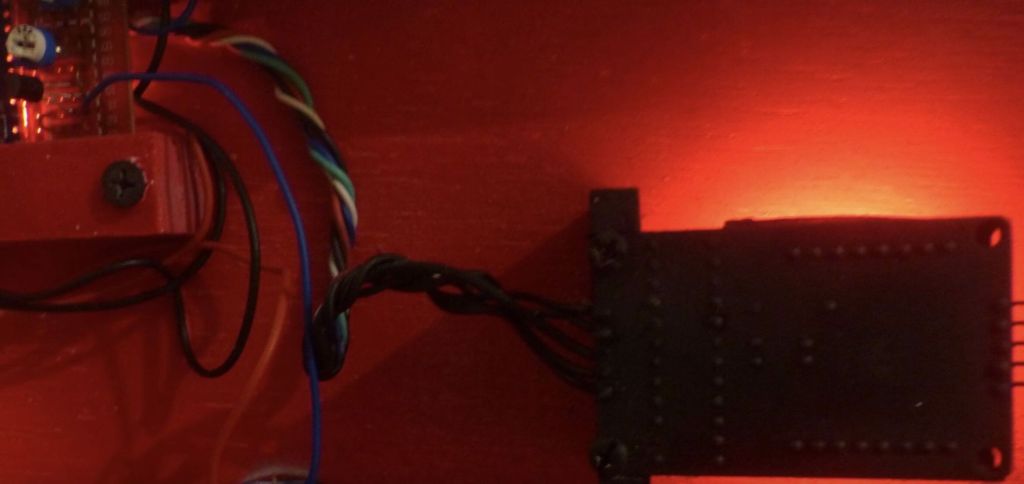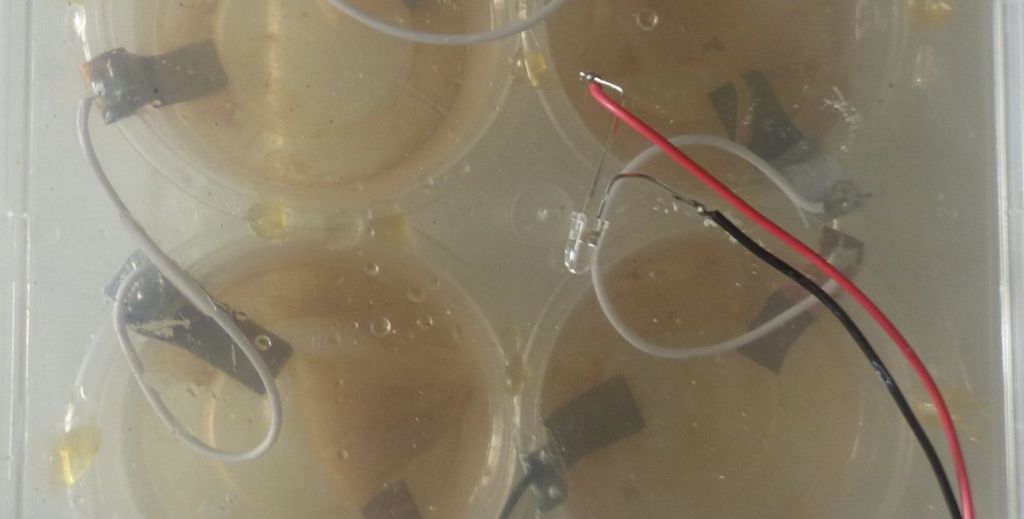Text by Nathalia Dutra Maciel

I feel something about the projects’ origins can be conveyed by a picture of me as a science student at the University of Hiroshima. It’s a bit cliched, but I was a goth. Dressed all in black, wore black nail polish, had my hair up in a ponytail, and sometimes went barefoot. I would be dressed this way as I peered into microscopes and dissected fish. My teachers let me go my merry way, thinking, I suppose, that as long as I got my work done, my personal choices were up to me. Plus, I was a foreigner anyway.
Tad Ermitaño, whose influence can be traced back to the late 1980s, is a significant player in new media art in the Philippines and South East Asia—regarded as one of the country’s forerunners of sound art and experimental film. His artistic practice has developed into a remarkable assertion of technology to create projects that examine the processes, senses, and structures surrounding man’s relationship with machinery.
His work frequently involves the manipulation of audiovisual events, which the artist mixes with an instinctual aesthetic awareness of the relationship between temporal and spatial aspects. Ermitaño uses a variety of technologies to communicate his fascination with sound, including analogue circuits (Bell, 2011), mechanical instruments (Hasa, 2015), and computer programming (Sammy and the Sandworms, 2013).
His work also holds interactivity elements, allowing for flexibility in how they are displayed and experienced. For instance, Twinning Machine (2012) is a computer-augmented video installation that simultaneously receives a live video feed from a camera, edits the film, and projections the edited pictures using software the artist created.
Held at Art Laboratory Berlin, Tad Ermitao now brings us; RADYO SOMATODELIA, Experiments in Sonic Animism: Somatodelia is an attempt to help dissolve the mind/body dualism by trying to show how the idea that the mind as this invisible, non-material, ‘spiritual’ independent thing is a falsehood that sweeps under the rug all the ways it depends on, originates in, is fed by the physical. For instance, when a person trembles, it is these physical gestures by which I know his mental state.
And by ‘know’, I don’t mean I deduce their mental state from the signs they display, but that these movements of their body are either mirrored or entangled in our own. The relationship between the observer and that which is being observed is thus intersubjective – we are merged in empathy. (Tad Ermitaño, Notes on Somatodelia).
The birth of Somatodelia, woven together by relationships and entanglements, human and more-than-human, seems to originate with a young university student. The piece creates linkages between time and space. Somatodelia paths its methods of wayfinding and intimate connections to generate relationships between varying places of existence.
These multitemporal frameworks are reflected in the piece’s complexity. Floating within these multilayered places of existence, Radyo Somatodelia mimics how our thoughts are birthed, formed through this dance between fragments of lived experiences that are seemingly unrelated but somehow in our neurological sphere exist in cohesion.
These days, I think it was a manifestation of some kind of effort to seek out or increase my proximity to the extraordinary, a drive which I think is why I was interested in science anyway. Science was a place of wonder. Where fire and rust were revealed to be the same process at different speeds, where speed slowed time down, where organisms could be cultured, their DNA spliced, and where sheep could be cloned. Science was where you looked under the hood of Reality…
I had become acutely conscious that the ecological apocalypse we are in the middle of could be laid at the door of science and the technology that leverages it.
I had begun to suspect that the scientific view that consciousness was an epiphenomenon — a by-product that had no bearing on the physical Reality of the universe — made it possible for human beings to use technology in ways that might be nakedly exploitative or even compensatory in vulgarly Freudian ways — and be completely beyond criticism that had any basis in the bedrock Reality that Science dealt with.
Ethics and Morality, even Psychology, rested on premises that were much more ephemeral and easily ignored. I suppose it is only logical that the Studies of Epiphenomena would be somewhat epiphenomenal in relation to Studies of Phenomena.

…I think I have a history of trying to make what might be “Sacred machines”. Machines that dealt in realms that were outside the strictly mechanical. Drone machines for meditation, Gamelan machines run by computers interacting with the audience through video avatars, and rhythmic machines for casting retribution.
A few years ago, I first encountered photographs of the tree bridges of Meghalaya in India. There are bridges woven from the aerial roots of banyan trees. Looking at these photographs, the phrase “animist technology” occurred to me. I’m not even sure what I meant by that, but I was struck by the realization that these wooden bridges were not built by destroying or killing trees, but by encouraging and leveraging the living forces in the trees.
As the trees grew older, their life forces actually made the bridges grow stronger in ways that bridges built from dead wood and quarried stone never did. This was a technology that surfed natural forces, a technology of cooperation, not of domination.
Those photographs might be the seed of this project. Or, to borrow an animist metaphor, perhaps the trees that were subjects of those photographs were the sponsors of this project, in which I try to go beyond/under the hood of the idea of an animist technology to speculations about the metaphysics that would generate/express itself in such a technological approach.
Creating new seeds of existence, Radyo Somatodelia dissolves conceptions of mind-body dualism and creates space for mindful and observatory navigation of how our mind/body exists in constant conversation. It is a reflection of our existence and how we communicate with each other through ways that exist outside and beyond linguistic capabilities. It gives us tools to navigate and reflect on the intimate, non-spoken connections that our bodies form with each other.
Exploring the way we move is a consequence of the way we have moved. Tad Ermitao invokes feelings of intimacy, bringing us to investigate our relationships. A lover’s tremble is now reframed into nuance. Pushing away from binary thinking, Somatodelia invokes us to reflect on our physical movements and create space for the subtleties in understanding how we move.
An animist metaphysics would for sure have choice of things to say about the place of consciousness — of humans and nonhumans in this universe. I suspect it would also talk about intentions and teleology — of things trying to become, or trying to reach for goals, or trying to grow into shapes or forms of existence that some part of them dimly suspects are there to be found. Regarding care and intimacy, it would be the founding attitude of animist metaphysics.
The metaphysics that we live with — where we are disembodied epiphenomenal intelligence in a sea of dead machinery — underpins commonsense ideas that definitely enable indifference and cruelty. Most of us do not act with indifference and cruelty in our immediate surroundings and towards our immediate circle, but metaphysics definitely makes it easier for, say, an executive to approve of policies that would stripmine a forest or disenfranchise communities.
I am hoping that an animist metaphysics would make the everyday care with which we face our immediate circle an attitude that would be the rule for dealing with everything.
Tad Ermitaño calls for radical care. Care regardless of perceived, predisposed connections, or judgments of value. Care for care. Somatodelia generates spaces for intimacy within these parts of ourselves that we might not perceive as controlled. Furthermore, it calls us to reevaluate how we often mindlessly interact with the world and the thongs around us.
Somatodelia is a call for introspection, in which, through understanding your relationships with others and other things, you come to more deeply understand yourself. Merged through concepts of empathy, Somatodelia creates spaces and mirrored reflections within these entanglements of intersubjectiveness between observer and observed.
It generates non-linear non-spoken bonds between all aspects and players within our existence. Living in nuance, Somatodelia challenges our understanding of relationships, how we speak about them, and what we mean. It extends, bends and contorts your previous conceptions of what you understand as truth, simultaneously giving you tools to uncover new ones.

I think empathy can easily be hijacked by dialogues that lead to paralysis. It is a false idea that simply because we can understand someone or something else, it should be impossible to hurt, kill or move aggressively against it/her/him. There is a kind of veganism which I think seeks a kind of guiltless existence on the planet — a way of living that kills no animal. Of course, even raising vegetables means eliminating insects and other animals that would compete for these resources.
Again, this seems to me a kind of obverse of human exceptionalism. We are primates and omnivores and no more expected to refrain from aggression and killing than orangutans and chimpanzees, and bonobos do. Animist cultures are filled with rites of sacrifice, which try to balance empathy with practices like hunting. I keep thinking about the title of William Burroughs’ book — the Naked Lunch.
We are in a phase of history, maybe where we are trying to bring out and contemplate all the forms of violence that we wreak upon the earth and try to minimize this violence. It is right to minimize violence and minimize cruelty where violence is inevitable or at least chosen. However, to believe that life can be lived without a footprint of blood is a fantasy. We are always occupying space that we are clear of others.
Somatodelia reframes our stoic understandings of reality and calls for explorations that are free of rigid academic barriers. It adopts the intimate entangled and intersubjective, generating an intimate channel of connection. It reevaluates animism as a language that speaks from inside this journey of wayfinding. It reclaims personal experience as a valid way of undertaking the world because, at the end of the day, what else do we have?
I am hoping people get a sense of “something out there.” Or maybe “things in here with us”. Just a suspicion that there might be ways of focusing attention that would be rewarded by returned recognition. I am thinking about that moment when an animal you observe from a distance meets your eye. There is this shock of recognition, which comes easily because we are fellow animals; the animal has eyes, turns its head, and so on. But what about things that do not share our biology? How would we feel “seen” by an earthworm or a stand of grass, or a rock? This is the sort of door I am knocking on.
Radyo Somatodelia runs until October 9 2022, at Art Laboratory Berlin.






